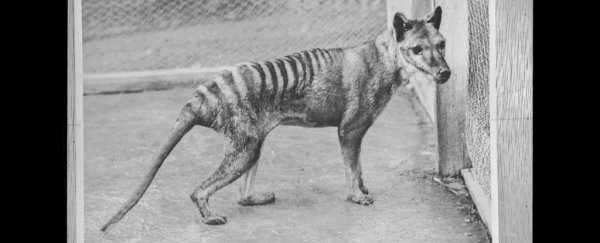The thylacine has long been considered a truly remarkable species. The extinct Australian beast was a marsupial, but its skull was distinctly canine in appearance, almost identical to the skulls of red foxes and grey wolves.
Now, new research has confirmed that this resemblance wasn't limited to adult thylacines (Thylacinus cynocephalus) - it was present even in the skulls of newborn pups, and persisted throughout the animal's lifespan.
The finding could shed more light on how different animals can evolve similar characteristics to occupy similar ecological niches, even though they might be unrelated and separated by space and time - a phenomenon known as convergent evolution.
"Remarkably," said biologist Andrew Pask of the University of Melbourne in Australia, "the Tasmanian tiger pups were more similar to wolf pups than to other closely related marsupials."
Although the thylacine - more commonly known as the Tasmanian tiger - was tragically driven to extinction by humans in 1936, its remains have been retained in museum collections. In collaboration with Australian museums, the researchers subjected a number of thylacine skulls at different life stages and sizes - from newborn to adult - to X-ray CT scans.
These were compared to other marsupial skulls from Australian museums, including those of the dunnart (Sminthopsis), recently found to be one of the closest genetic relatives to the thylacine, and the eastern quoll (Dasyurus viverrinus), another carnivorous marsupial of the same order as the thylacine.
From the Museum of the North in Alaska, the team also borrowed and CT scanned skulls from the grey wolf (Canis lupus), again at different life stages and sizes from newborn to adult, to compare to the thylacine skulls. The last common ancestry between the two species was 160 million years ago.
 Thylacine (left) and wolf (right) skulls. (The Pask Lab)
Thylacine (left) and wolf (right) skulls. (The Pask Lab)
"We know that the thylacine and wolf look similar as adults, but we don't know when they started to exhibit their remarkable similarities during development," explained biologist Axel Newton of Monash University in Australia.
He and his team recently reconstructed the pouch development of thylacine pups. That research also contributed to this comparison, allowing the team to look for similarities between thylacines and other marsupials or wolves at the very earliest stages of life.
Recent research by a team that included Pask and Newton found that wolves and thylacines have similar genes regulating their craniofacial development. The new research, comparing the skulls of the two animals, backs this up. From birth to adulthood, the skulls of the two animals not only resembled each other, but followed a similar growth pattern.
Previous research has suggested that the way marsupials are born - developing in a pouch, rather than placentally - places limits on how varied their skulls can be. This new study shows that not only can convergent evolution take place in animals that are otherwise anatomically different, but that marsupials can evolve wildly different skulls from each other.
And the comparison between the two species is a fascinating example that can be used to study the emergence of convergent evolution more broadly.
"By comparing entire growth series from newborns to adults," said biologist and palaeontologist Christy Hipsley of Museum Victoria and the University of Melbourne in Australia, "we were able to visualise tiny differences in development that pinpoint when and where in the skull adaptations to carnivory arise on a cellular level."
Convergent evolution such as this is a powerful reminder of just how much the environment shapes our anatomy and physiology over hundreds of thousands of years of evolution. All animals, including us humans, are deeply intertwined with our world.
The research has been published in Communications Biology.
